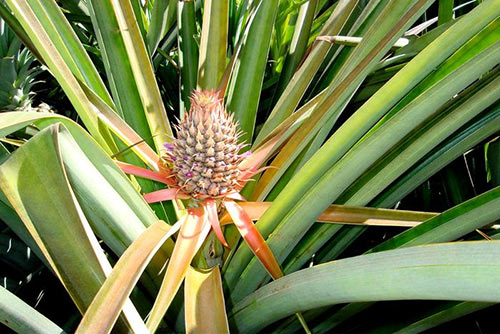![The pineapple genome offers new insights into the evolution of the pineapple and of crop plants such as sorghum and rice. [Robert Paull, University of Hawaii]](https://genengnews.com/wp-content/uploads/2018/08/Nov6_2015_RobertPaullUnivHawaii_Pineapple1971881876-1.jpg)
The pineapple genome offers new insights into the evolution of the pineapple and of crop plants such as sorghum and rice. [Robert Paull, University of Hawaii]
Fruits such as the pineapple often conjure up images of carefree days spent in tropical paradise lounging on white sandy beaches, sipping delicious exotic cocktails. Few realize the evolutionary adaptations that were necessary by the pineapple to thrive in the water-limited environments where they most often grow.
Yet, an international team of scientists have completed the genome sequence for the pineapple plant, which has shed new light on the complicated evolutionary history of grasses such as sorghum and rice that share a distant ancestor with pineapple. Humans began cultivating the plant more than 6,000 years ago; today, roughly 85 countries produce about 25 million metric tons of the fruit per year.
At the genetic level, like many other plants, ancestors of pineapple and grasses experienced numerous doublings of their genomes. Tracking the remnants of these whole-genome duplications has helped researchers trace the shared—and independent—evolutionary histories of these important crops.
“Our analysis indicates that the pineapple genome has one fewer whole genome duplication than the grasses that share an ancestor with pineapple, making pineapple the best comparison group for the study of cereal crop genomes,” said Ray Ming, Ph.D., professor of plant biology at the University of Illinois, lead author of a new study.
The findings from this study were published recently in Nature Genetics through an article entitled “The pineapple genome and the evolution of CAM photosynthesis.”
Another interesting development that resulted as a consequence of the completed pineapple genome was the larger insight into the different modalities of photosynthesis that plants utilize. For example, pineapples make use of a special type of photosynthesis, called crassulacean acid metabolism (CAM), which has evolved independently in more than 10,000 plant species. Most crop plants use a different type of photosynthesis, called C3, and other tropical plants utilize a pathway called C4.
“CAM plants use only 20% of the water used by typical C3 crop plants, and CAM plants can grow on dry, marginal lands that are unsuited for most crop plants,” Dr. Ming noted.
When the researchers took a closer look at the genome, they found that some of the genes contributing to CAM photosynthesis are regulated by the plant's circadian clock genes, which allow plants to differentiate day and night and adjust their metabolism accordingly.
“This is the first time scientists have found a link between regulatory elements of CAM photosynthesis genes and circadian clock regulation,” Dr. Ming remarked. “This makes sense because CAM photosynthesis allows plants to close the pores in their leaves during the day and open them at night. This contributes to pineapple's resilience in hot, arid climates, as the plant loses very little moisture through its leaves during the day.”
This temporal regulation of this metabolic pathway allows the plant to absorb and fix CO2 during the cooler night temperatures and release it the next day during photosynthesis.
“Drought is responsible for the majority of global crop loss, so understanding the mechanisms that plants have evolved to survive water stress is vital for engineering drought tolerance in crop species,” the researchers wrote. “CAM plants can keep their stomata closed during the daytime—greatly reducing water loss.”
Additionally, the researchers discovered that CAM photosynthesis evolved through the genetic reconfiguration of the molecular pathways involved in C3 photosynthesis.
“All plants contain the necessary genes for CAM photosynthesis, and the evolution of CAM simply requires rerouting of preexisting pathways,” the authors noted.
This is an important finding that could have major implications for the development of drought-tolerant varieties of essential crops. Adapting food crops to be more tolerant of drought may help humans adapt to climate change.
“Higher water-use efficiency is a highly desirable trait, given the need to double food production by 2050 in the context of a changing climate,” Dr. Ming concluded.



